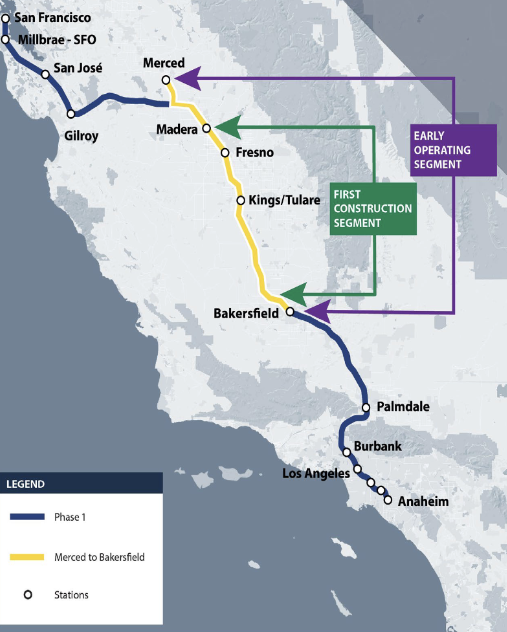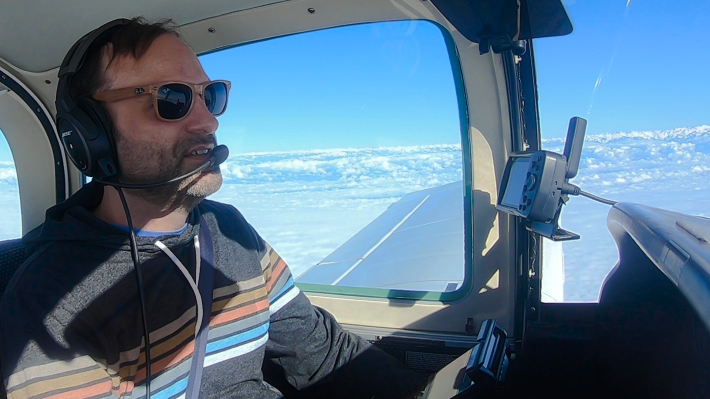Note: GJEL Accident Attorneys regularly sponsors coverage on Streetsblog San Francisco and Streetsblog California. Unless noted in the story, GJEL Accident Attorneys is not consulted for the content or editorial direction of the sponsored content.
Perhaps the only way to appreciate 119 miles of high-speed rail construction through remote parts of the Central Valley is by flying over it. So that's what L.A.-based videographer and small-plane pilot Bryan Keith did one day in mid August.
Keith runs the Wolficorn YouTube channel and service, which provides aerial shots of large projects and landmarks. That lets him combine his two passions while giving people a chance "to look at things from an aerial perspective."
As it turns out, he also appreciates modern, fast trains and the time and environmental benefits they offer. "I’ve ridden trains in Europe and the eastern U.S. and in California," he told Streetsblog. He considers himself a supporter of California's much maligned high-speed rail project to link San Francisco, L.A., and the Central Valley with efficient, 220-mph electric trains. "I think a lot of the negativity and the anti-HSR sentiment comes from people who just don’t know what they don’t know. They don’t understand the benefits."
The other thing they don't understand is just how much of California's high-speed rail project is nearly finished, including the spine of the system. There is over 100 miles of built-entirely-from-scratch right of way (ROW) from just outside Bakersfield to Madera.
Unfortunately, naysayers on the high-speed rail project have, in the past, spread the myth that all that's been built are a few large viaducts and bridges. Actually, as Keith shows in the embedded video above, those are only the most dramatic structures in a long roadway that is now ready for tracks to be laid. Acquiring the land, grading, and providing drainage, connecting it all: the prep was the hard part. Laying tracks with modern machinery is relatively easy. It's mostly automated, with a robotic train that lays the tracks as it goes.

That said, the most daunting section of the project, from Burbank to Bakersfield, which includes the Tehachapi mountains, is still not built, as Keith also documents in his video. The video really illustrates how challenging that section will be, but also points out that it was bridged with conventional rail in the 1800s, so it can be done again. As to the cost, Keith said he was in the U.K. when the English Channel Tunnel opened. "Nobody in that country remembers one bit of the fact that it went over budget," he said. Adding that Japan also went over budget with the construction of its famous bullet-train lines, which bridged and tunneled across enormous mountains and faultlines.
Keith explained that getting all the clearances for his flight wasn't easy, either. His plan was just to document construction in the Central Valley. But, as it turns out, restrictions around the edge of LAX airspace pretty much forced him to also fly over the future route of the ROW from LA to Bakersfield, which is why he ended up documenting that too. Eventually, he may do a second video and fly over the Pacheco pass, where HSR will eventually connect from the Caltrain tracks at Gilroy to the Central Valley. He explained that there are simply too many restrictions around SFO to fly all the way up Caltrain's ROW into San Francisco, which will eventually be part of the HSR route.

It seems appropriate, coming out of the Labor Day Weekend traffic and airport crunch, to feature and update what's coming—if the state will just put its financial nose to the grindstone and start diverting funds from pointless road widening to its High-speed Rail Program. "We as a country accept traffic and airport delays because that’s what we’re used to," said Keith. "If the HSR were there, you would go to the station right before it arrives, hop on, read a book, and you'd be there in 2.5~3 hours. It’s a much more pleasant experience." For the record, California's HSR will be about 90 mph faster than Keith's propeller plane.
Be sure to check out the video.






